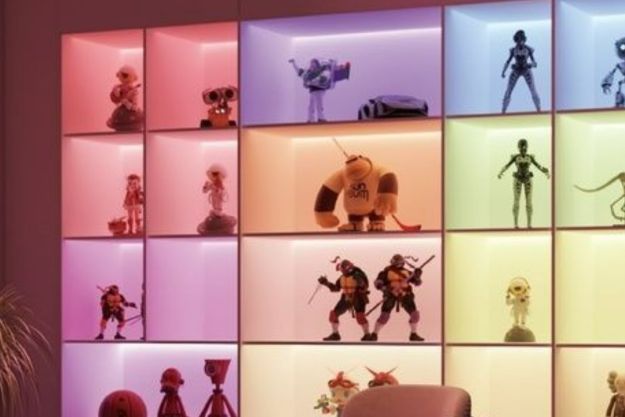It started off innocently enough. I had a small project that I wanted to do, and I needed a multicolor smart bulb to do it. At the same time, it was a silly little project, so I didn’t really want to spend all that much money on it. Until then, I’d only purchased Philips Hue white bulbs, which are nice – but a bit pricey. Surely, there’s a less expensive option. Right?
Do the math. Smart lights are expensive!
Smart lighting is one of the biggest investments you can make into your smart home. Don’t believe me? Take a look around your home and count the number of light bulbs in your home. From where I’m sitting in my kitchen as I write this, I can see 12 light bulbs that would need to be replaced. Conservatively, a white smart bulb is around $20 or so.
Quick math says that from where I sit, I need to drop around $240 just to replace the bulbs I can see. I could replace all the bulbs in my house with white-only bulbs, or get a nice OnePlus phone. It’s not an easy call. For colored light bulbs from Philips, the cost is considerably more. But let’s get back to my project.
I decided I was smarter than all that, so I went on Amazon and searched for a cheaper alternative. Wow, holy cow! I found a set of four smart light bulbs, full color, from Magic Home WiFi, for $35! That’s just over $8 per bulb! Goodbye to you, Philips Hue!
Installation was typical. You download the app, and since there’s no bridge, you connect each bulb individually via its own Wi-Fi. Once you connect to the app, you can use it to do the usual controls — like change the colors and turn them on and off. There are even some neat app functions like synchronizing lights to music, or using your camera to change the light to a specific color. You can link your account to Google Assistant, so you can bypass the app entirely if you want to. Amazing! But then, things took an unfortunate turn.
The wheels come off
I don’t recall what exactly was the first blip on the radar. I think it had something to do with me having the audacity to turn off the light switch for the fixture the bulbs were in. Suddenly, those two just stopped working. It took me about 20 minutes or so to get them back up and running. It turns out there’s a fairly standard method of resetting the bulbs by turning them off and on three times. But then I had to go through the whole setup procedure again.
Suddenly, one or more of the bulbs will stop working and I’ll have to troubleshoot it.
I’ll spare you a detailed account of every time I had to go through that same procedure. It’s in the dozens by now. The cause can be anything including a temporary loss of Wi-Fi (for example, resetting my router), a temporary loss of internet, accidentally flipping the light switch, or just it being a day that ends in “Y.” Suddenly, one or more of the bulbs will stop working and I’ll have to troubleshoot it, burning away anywhere from 10 to 30 minutes.
Adding insult to injury, about three months after I bought the bulbs, one of the four just stopped working entirely. When that happened, dear reader, I simply threw it in the trash. I didn’t research to see if there was a way to reset it, or look to see if there was some kind of fuse. I am just so sick of these things that the day they fail to respond to a minimal amount of troubleshooting, they will go into the trash.
More money goes a long way

There is a lesson to be learned here. “You get what you pay for” comes to mind. “Read Amazon reviews more closely” is another. If there is anything that I have learned about smart home technology, it’s that there are several name brands that stand out in each category, and they are name brands for a reason. A smart home needs to be smart, and these bulbs are not. I actively hate them now.
But I also consider them a lesson well learned. When it comes to smart tech, don’t be cheap. If a name brand that you recognize is a lot more expensive than some knock off brand from wherever, there’s a good chance it’s because they have put in extra amounts of research and development and quality assurance testing to ensure a premium customer experience. Definitely read reviews, like those here at Digital Trends, for example. But also, before you take ta risk to try out some less expensive option, make sure that it’s worth the extra effort that may go into setting it up, or maintaining it long-term. Otherwise, you’re better off just paying a little bit more and enjoying an easier life.
Oh, and that project I was working on. Appropriately, the light bulb I used for that is the one I have the least amount of trouble with. I make it turn red when I’m recording a podcast, so other members of my household know to be quiet. I’ve still had to reset it a few times, but that one bulb has worked fairly well. The other three were complete dumpster fires, and had it not been for that package deal, this opinion piece may have slanted in an entirely different direction. As it stands, it’s a valuable lesson that’s well worth the $35 it cost me — and the $35 it will save you from spending.
Editors' Recommendations
- Daisy is an installation and repair company designed for your smart home
- I checked out Govee’s new AI smart lights and now I want them everywhere
- Eve expands Matter lineup with smart outlet, light switch, and blinds
- Why moving your smart home could be a nightmare
- Break out of a rut with these useful summer-focused smart home routines







